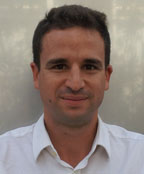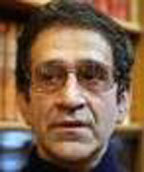
Clément Therme
Clément Therme is an Associate Fellow at the Centre d’analyse et d’intervention sociologiques at EHESS in Paris and a Research Fellow for the Programme for the Study of Global Migration at the Graduate Institute (Geneva). He is also a Teaching Fellow at the Department Politics, Languages & International Studies at the University of Bath. He received his PhD in international relations from the Graduate Institute and his PhD in sociology from the EHESS examining the Soviet-Russian case in Iranian foreign policy since 1979. He has published several articles for IFRI (Politique étrangère) and for the Institut Choiseul (Maghreb-Machrek and Politique américaine). He is the author of a forthcoming book entitled Téhéran face à Moscou depuis 1979 to be published by the French University Press (PUF).

H. E. Chehabi
Professor of International Relations and History. (Licence, Universite de Caen; Diplôme, Institut d'Etudes Politiques de Paris; M.A., Ph.D., Yale University) Specialization: Middle Eastern Politics and Cultural History, International Law. Professor Chehabi has taught at Harvard, Oxford, and UCLA, and has held Alexander von Humboldt and Woodrow Wilson fellowships. He has published two books, Iranian Politics and Religious Modernism: The Liberation Movement of Iran under the Shah and Khomeini (1990) and Distant Relations: Iran and Lebanon in the Last 500 Years (2006). He has also co-edited Politics, Society, and Democracy: Comparative Studies (1995) and Sultanistic Regimes (1998). Professor Chehabi has written numerous articles, book reviews, and translations.

Farhad Khosrokhavar
Farhad Khosrokhavar is a Professor at the Ecole des Hautes Etudes en Sciences Sociales (EHESS) in Paris, France. His main fields of study are Iranian society after the Islamic Revolution and Islam, in particular its radical forms in Europe and the Middle East. He has published 17 books, three of which translated in nine different languages and more than 70 articles, in French, in English, and in Persian. He has been a Rockefeller Fellow (1990), has given conferences in different European and American universities (Saint Antony’s College at Oxford, Princeton, NYU, Columbia, UCLA, USC, Stanford, Harvard, Yale, Texas University at Austin). He was a Yale Visiting Scholar in 2008 and a Harvard Visiting Scholar in 2009. His latest books are: "Muslims in Prison: a comparative perspective between Great Britain and France" (avec James Beckford et Danièle Joly), Palgrave, London, 2005, "Suicide Bombers, The New Martyrs of Allah" (translation from French), Pluto Press, Michigan University Press, 2005, "Quand Al Qaeda Parle: témoignages derrière les barreaux," Grasset, Paris, 2006, "Inside Jihadism: Understanding Jihadi Movements Worldwide" (Yale Cultural Sociology Series), Paradigm Publishers, 2009, "Etre jeune dans le pays des ayatollahs" (in cooperation with Amir Nikpey), Robert Laffont Publishers, Paris, 2009, "Jihadist Ideology, The Anthropological Perspective," CIR, Aarhus University, Danemark, 2011, and "The New Arab Revolutions that Shook the World," Paradigm Publishers, 2012.
FOREWORD
Beyond Boundaries, the Passion for Knowledge
Alessandro Monsutti
A personal appreciation of Mohammad-Reza Djalili as a human being.
INTRODUCTION
Mohammad-Reza Djalili: Between the East and the West.
H. E. Chehabi, Farhad Khosrokhavar, and
Clément Therme
The editors of the book provide an intellectual biography of Mohammad-Reza Djalili and introduce the chapters of the book.
CHAPTER 1
The Green Movement: Social Innovation in an Authoritarian Regime.
Farhad Khosrokhavar
The author presents the historical background of the Green Movement, going back to the Constitutional Revolution of 1905—1911. He analyses the innovative nature of this new social movement, and explains its relative failure to undermine the theocratic nature of the Islamic Republic in light of the contemporaneous Arab Spring.
CHAPTER 2
The Shah’s Two Liberalizations: Re-Equilibration and Breakdown.
H. E. Chehabi
The author puts the failure of the reformists to effect a genuine liberalization of the Islamic Republic’s political regime in perspective by providing a comparative analysis of the two liberalizations that occurred under Mohammad Reza Shah: that of 1960-63, which ended in a reconsolidation of the Shah’s rule, and that of 1977-78, which ended in revolution.
CHAPTER 3
The End of a Beautiful Friendship? Mahmud Ahmadinezhad and the Principalists
Walter Posch.
The author focuses on factionalism within the Islamic regime and points out the momentous consequences of the emergence of a new ‘principalist’ political faction before and after the presidential election of 2009.
CHAPTER 4
“Human Rights”: By Any Other Name: Iranian Activism in an Authoritarian State
Arzoo Osanloo
The author draws our attention to an understudied question, namely the activities of legal reformers inside the Islamic Republic. Osanloo shows how difficult it became, in the aftermath of the 2009 election, to defend women’s rights and human rights in Iran. Nevertheless, the author’s main argument is that activism continues in innovative forms as part of a dialogical response to the new constraints.
CHAPTER 5
Inter-Confessional Relations in Iran: Conflicts and Transfers in the Aftermath of 9/11.
Stéphane A. Dudoignon
The author delves into the hitherto neglected topic of the Sunni question in the Islamic Republic of Iran and introduces the world vision and strategies developed by the religious and political leaders of the Sunni minority of Iran. Against the background of a relatively low level of interconfessional confrontation in Iran since the emergence of the Islamic Republic in 1979, Dudoignon analyses the appearance of Sunni-Shiite violence in 2009.
CHAPTER 6
Political Culture, Use of History, and Democracy in Iran.
Firouzeh Nahavandi
The author explores the manipulation of Iranian political culture by both the Pahlavi monarchy and the Islamic Republic. She rightly observes that in the social construction of the past, ‘democracy is rarely mentioned’ and that one of the main challenges of the twenty-first century in Iran, if it is to become a real democracy, is to switch to a new political culture based on the rights of the people and not the past.
CHAPTER 7
Nationalism, Myth, and History in Modern Iran.
Ali M. Ansari
The author discusses the recent rise of nationalism that challenges the official ideology of the state. He persuasively demonstrates that the change within Iranian society, towards a renewed interest for Iran’s pre-Islamic past, will inevitably affect the political class. This can already be seen in President Mahmud Ahmadinezhad’s enthusiasm for integrating Iran’s pre-Islamic past into the official discourse of the Islamic Republic.
CHAPTER 8
The Short-Term Society: A Comparative Study in the Problems of Long-Term Political and Economic Development in Iran.
Homa Katouzian
The author offers a long-term historical analysis of Iran short-term society. Regarding the most recent period of the history of the Islamic Republic, he challenges the forecasts which promise the imminent fall of the Islamic regime because, according to his view, there is at the moment no major external threat to the regime. He concludes outlining the unpredictability of Iran’s future given its definition as ‘the country of possibilities’. The last two chapters of Part One consider the economic situation of Iran.
CHAPTER 9
How to Transform a Rent-seeking Economy: the Case of Iran.
Thierry Coville
The author uses the case of the Iranian economy to illustrate the difficulties of transforming a rent-seeking economy. He emphasizes that Iran needs to focus on economic development in order to fulfill its quest for power on the regional and international scene. This chapter notably examines the main options facing the Iranian leadership to solve the structural problems of the Iranian economy.
CHAPTER 10
Energy Subsidies in Iran.
Narsi Ghorban
The author persuasively demonstrates that one of the main challenges of the Iranian economy for the twenty- first century is the reform of energy subsidies. He acknowledges the widespread consensus among experts both inside and outside Iran regarding the need to reform the price of energy. Nevertheless, he also recognizes that the Iranian leadership is facing two main hurdles: first, the government needs to be efficient and wise in implementing the subsidies reform bill in order to limit the political and social costs of the reform, and second, outside political and economic pressures are complicating the reform policy started in 2010 after many years of inaction.
CHAPTER 11
The Role of Ideology in Iranian Foreign Policy.
Mehdi Mozaffari
The author focuses on a specific aspect that is missing in the literature regarding this otherwise widely studied topic, i.e., the fact that Iranian foreign policy is guided by a totalitarian ideology rather than by national interest.
CHAPTER 12
Iran’s Cultural Diplomacy.
Nadia von Maltzahn
The author focuses on Iran’s cultural diplomacy. She explains the institutional framework of Iran’s cultural apparatus and the efforts of the Islamic Republic leaders to improve the coordination between different institutions dealing with Iran’s cultural activities abroad. She also analyses the flexibility of Iran’s cultural diplomacy: at the regional level, Tehran attempts to strengthen its cultural reach by promoting the Persian language, whereas in Southeast Asia, Iran’s cultural discourse focuses more on Islamic matters.
CHAPTER 13
“Dialogue” in the Foreign Policy of the Islamic Republic of Iran.
Clément Therme
The author explains that for the Islamic Republic, the idea of dialogue is first and foremost conceived to guarantee the survival of the Islamic revolutionary state in the context of the Cold War as well as in an international system with the United States as a dominant power. He then explores the historical background of Khatami’s diplomatic discourse of dialogue of civilizations, noting the decisive intellectual work of Dariush Shayegan.
CHAPTER 14
France and Iran: Between Tensions and “critical dialogue.”
Denis Bauchard
The author provides new insights into the troubled diplomatic relationship between Iran and France, notably after the Islamic revolution of 1979. What distinguishes this contribution from the rest of the literature is the Bauchard’s experience as a former diplomat, in which capacity he has dealt with the diplomats of the Islamic Republic of Iran as a representative of the French state.
CHAPTER 15
Iran’s Asian Strategy: The Importance of Economic Ties.
Thierry Kellner
The author offers a new perspective on Iran’s policy in Asia. He shows that Iran’s strategy in Asia took shape after the death of Ayatollah Khomeini and notes that Iran’s Asian foreign policy has remained unchanged under the successive presidential administrations of Rafsanjani, Khatami, and Ahmadinezhad. After reviewing the historical background of the political and economic connections between Iran and Asia, the author concludes that this aspect of Iran’s foreign policy cannot be ignored by Westerners, given their long-term nature.
CHAPTER 16
Iran and Syria: An Enduring Alliance.
Jubin M. Goodarzi
The author offers a new interpretation of the alliance between Iran and Syria, showing that, contrary to the view of many analysts who insist on the short-term dimension of this astonishing alliance between a religious theocracy and a secular autocracy, it is of enduring nature.
CHAPTER 17
Iran and the Twenty-First-Century “Persian world”: A Tajik Perspective.
Frédérique Guérin
The author offers a useful and timely study of the Tajik perspective on the Persian world. Guérin shows that the shared cultural legacy between Iran, Tajikistan, and Afghanistan is a soft-power tool of Iran’s contemporary foreign policy, used to increase its regional influence. She concludes that the three countries’ shared history and culture notwithstanding, the Persian world is fragmented.
Tabula Gratulatoria